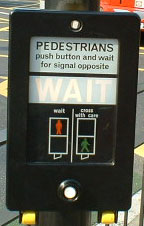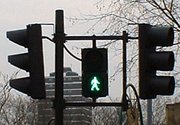Pelican crossing
|
|
A pelican crossing, (from Pelicon crossing: PEdestrian LIght CONtrolled crossing, a synonymous term) is a type of pedestrian crossing. It features a standard set of traffic lights, plus a push button and a further two coloured lamps for pedestrians using the crossing.
The Pelican Crossing was the first definitive light controlled crossing, introduced in 1969, after the earlier failed experiment of the Panda crossing. Previously only zebra crossings had been used, which have warning signals (Belisha beacons), but no control signals. The pedestrian lights are situated on the far side of the road to the pedestrian. A Puffin crossing has the lights on the same side as the pedestrian; a Toucan crossing is a crossing for pedestrians and bicycles.
In most countries, lights for pedestrians use the image of a "green man" pictured walking (although white is also a common colour), and a "red man" pictured stationary or a "stop hand" suggesting the hand gesture for stop. In parts of the United States (particularly New York City) these lamps may take the shape of "Walk"/"Don't Walk" messages, although pictograms are also seen in some regions. In most of the US, the difference is more often related to the age of the intersection — for decades, only words were used for the signals. The pictograms have only started being used in the last 20–30 years.
Pelican type crossings sometimes have further non-visual indication that it is safe to cross, such as a beep, vibrating button or tactile rotating cone in order to assist blind or partially sighted pedestrians.
East Germany had a somewhat old-fashioned pictogram on the lamps. After the reunification (German Unity Day) it became a cult — the Ampelmännchen (little traffic light man). However, the style in the western states did not change.
Granada's "green man" is really walking. These traffic lights use coloured LEDs which form a picture out of dots. Activation and deactivation of some dots over time create the appearance of movement.
External links
- BBC article (http://news.bbc.co.uk/onthisday/hi/dates/stories/april/2/newsid_2840000/2840919.stm), on the introduction of Panda crossings, and subsequent developments.


